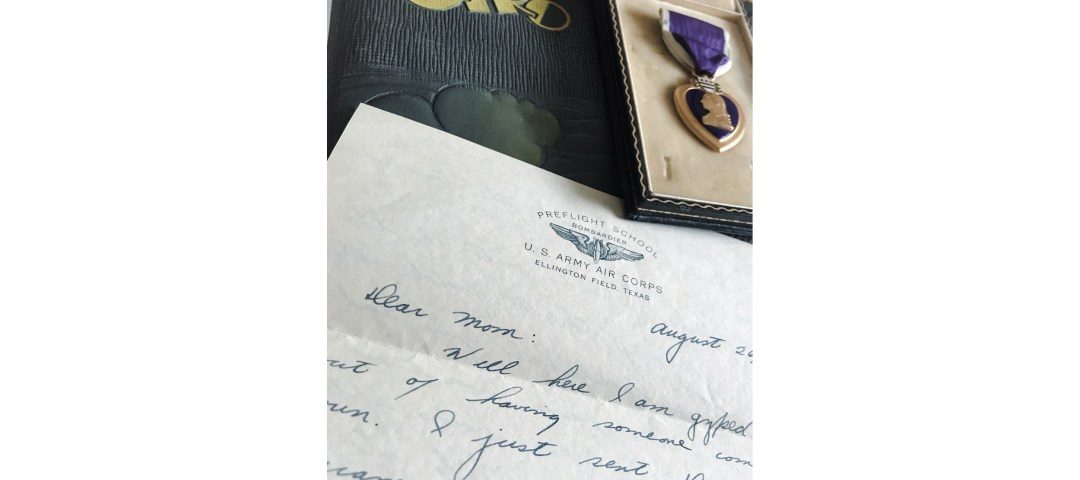When Jack Harrington handed me a stack of B-24 Liberator items from World War II, his only request was, “Maybe you can use this for something and share it with others who’d appreciate it.” The items he handed me were from Charles “Bud” Swanson, a member of his family who had been a crew member on the B-24.
I opened a yearbook from Class 44-4 of bombardier training at Ellington Field in Texas. The inside of the book was filled with signatures and funny notes from fellow crew members and classmates from this school. Some even made amusing comments about adventures they had together. As I flipped through the book, a letter fell out. I opened the carefully folded letter to see that it was on letterhead from Ellington Field. The handwriting was very neat and clear, and easy to read.
The letter is to his mother, Ethyl Swanson. It starts off with him talking about the fact a new restriction cancelled a visit his parents had planned. “Dear Mom, I sure am having bad luck,” Charles wrote. “I guess I’ll never get to see any of you folks until this war is over.”
He went on in this two-page note to ask about family and also mentioned that they were going stir-crazy in their barracks and could badly use a small radio, if any might be had. “I know they are getting hard to come by, but we sure would appreciate it,” Charles wrote. “Me and the boys are going crazy.”
Charles mentions that he had been up to 38,000 feet in a compression chamber and that he was in his final stages of training. “I just have one last class left,” he wrote. “Aircraft recognition. After that I’m off to bombers.”
He then realized he would not be able to be home for his Mom’s birthday. “I won’t be able to be there, but know that I did not forget,” Charles wrote. He asked about writing a few family members and then brought the letter to a close with “Love Bud,” followed by the same in Morse code.
I appreciated the letter from a few different aspects. Writing letters such as this is almost a lost art form. It’s really neat and not rushed. This was truly a way to spend some time, and it was also very pure. A young man writing home to his mom, asking for a radio, and thanking her for sending some candy.
After reading all of it, you started to feel like you were getting to know Bud a little, and I couldn’t wait to find out more about his service. In the pile of wonderful items Jack gave me was a metal box — navy blue with gold trim. I opened it up to see a silk handkerchief, which looks like an item that could be purchased at a base PX. On it was the USAAF insignia embroidered along with the word “Mother.” I moved it aside to find a Purple Heart. I then took a moment to pause. It brought home the fact that this young guy writing a letter home thanking his mom for candy was the same guy who earned a Purple Heart in a B-24.
I then decided before I went any further into his personal items that I’d like to find out where he served. After a little research I found that he had been assigned to the 448th Bomb Group, 713th Bomb Squadron. They flew missions in the European theater of operations. Then I found a tail number and a name of their aircraft. Charles became the bombardier on a B-24H Liberator named Lonesome Lou. It was known to the USAAF as B-24 #41-29465.
My next move was to pull that aircraft history up. And that’s when I saw the ultimate fate of Charles and the rest of the crew of Lonesome Lou. On August 5, 1944, they were on a mission to Fallersleben, Germany. Their aircraft was attacked by fighters. Due to the damage the pilot, Donald Ginevan, decided to attempt a ditching of the aircraft in the North Sea. Landing a B-24 in the water with the high wing was not an easy task.
No one really knows what happened in the moment of the crash, except that 10 men aboard perished. When I read the KIA next to Charles’ name, it felt like I had been punched. It was his first mission. As I went through the other items, I could only imagine the grief of his family and friends. The phrase “I’ll never get to see any of you folks until this war is over” from his letter stuck in my head. While this is certainly a somber story, it is also one that is important to remember. It’s a reminder that these folks were not just black-and-white photos. They were real people. They were sons, husbands, and friends.
I am thankful for Jack trusting me with this portion of his family history. It’s truly a great reminder of what we are working to preserve and share with our younger generations so that they know what was sacrificed.


